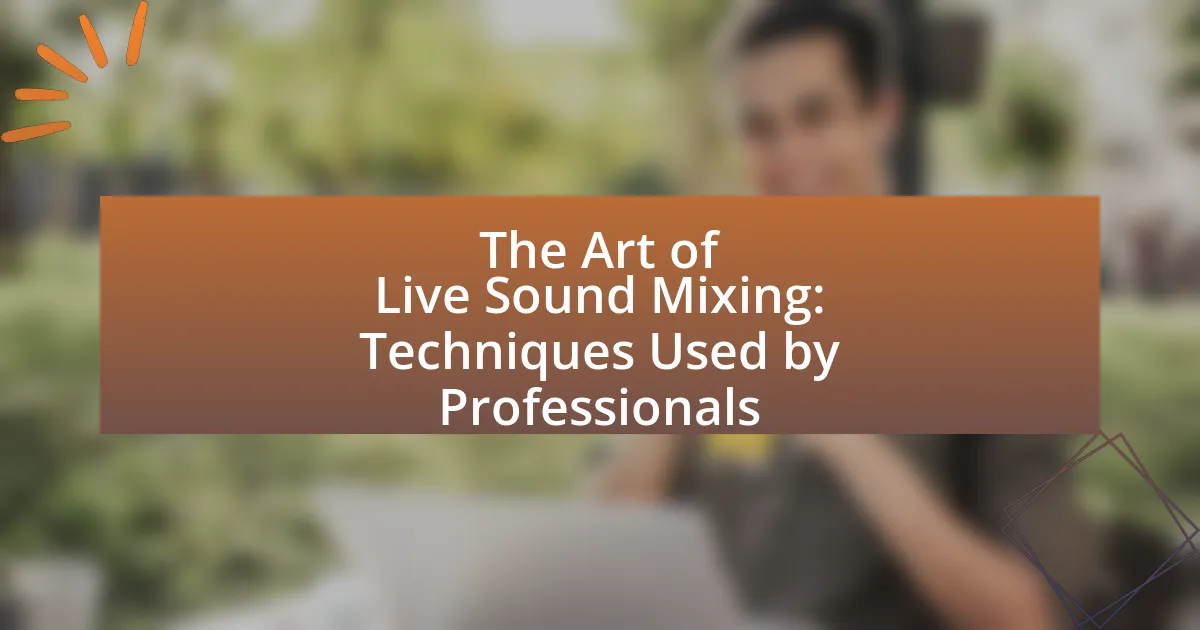The main entity of the article is the art of live sound mixing, which involves the skillful blending of audio elements during live performances to create a balanced and cohesive sound. The article outlines the differences between live sound mixing and studio mixing, emphasizing the importance of real-time decision-making and the key elements involved, such as sound sources, mixing consoles, and effects. It also discusses techniques used by professionals, the significance of sound quality, and best practices for effective mixing, including sound check procedures and strategies for managing sound levels and feedback. Overall, the article provides a comprehensive overview of the essential skills and techniques required for successful live sound mixing.

What is the Art of Live Sound Mixing?
The Art of Live Sound Mixing is the skillful process of blending audio elements during live performances to achieve a balanced and cohesive sound. This involves adjusting levels, equalization, and effects in real-time to enhance the auditory experience for the audience. Professionals utilize various techniques, such as dynamic range control and spatial placement, to ensure clarity and impact of each sound source, whether it be vocals, instruments, or ambient sounds. The effectiveness of live sound mixing is evidenced by the ability to adapt to different acoustic environments and the diverse requirements of various performances, demonstrating the importance of both technical knowledge and artistic sensibility in achieving optimal sound quality.
How does live sound mixing differ from studio mixing?
Live sound mixing differs from studio mixing primarily in the environment and the immediacy of the performance. In live sound mixing, engineers must adapt to real-time conditions, such as audience noise and venue acoustics, requiring quick adjustments to maintain sound quality. Conversely, studio mixing allows for a controlled environment where sound can be manipulated with precision over time, enabling detailed editing and effects application. The necessity for immediate decision-making in live settings is supported by the fact that live performances often involve multiple sound sources and unpredictable variables, while studio mixing benefits from the ability to isolate tracks and utilize advanced software tools for refinement.
What are the key elements of live sound mixing?
The key elements of live sound mixing include sound sources, mixing console, equalization, dynamics processing, effects, and monitoring. Sound sources refer to instruments and vocals that need to be amplified and mixed. The mixing console is the central hub where audio signals are combined and adjusted. Equalization is used to enhance or reduce specific frequency ranges to improve sound clarity. Dynamics processing controls the volume levels and dynamics of the audio signals, ensuring a balanced mix. Effects, such as reverb and delay, add depth and texture to the sound. Monitoring involves using speakers or in-ear monitors to ensure that the mix sounds good to the performers and audience. These elements work together to create a cohesive and professional sound experience in live settings.
Why is real-time decision-making crucial in live sound mixing?
Real-time decision-making is crucial in live sound mixing because it allows sound engineers to immediately respond to dynamic changes in the audio environment. In live settings, factors such as audience reactions, performer dynamics, and unexpected technical issues can arise, necessitating instant adjustments to maintain sound quality and balance. For instance, a sudden increase in vocal volume may require immediate attenuation to prevent feedback, ensuring clarity and preventing distortion. This ability to make quick, informed decisions directly impacts the overall listening experience, as studies show that effective real-time adjustments can enhance audience engagement and satisfaction during performances.
What are the primary goals of live sound mixing?
The primary goals of live sound mixing are to achieve a balanced and clear audio experience for the audience while ensuring that all sound sources are appropriately amplified and blended. This involves adjusting levels, equalization, and effects to enhance the overall sound quality. For instance, a sound engineer must manage the mix to prevent feedback and distortion, which can detract from the performance. Additionally, the engineer must adapt to the acoustics of the venue, ensuring that the sound is consistent throughout the space. These goals are critical for delivering a professional and enjoyable live performance.
How does live sound mixing enhance the audience’s experience?
Live sound mixing enhances the audience’s experience by ensuring optimal audio clarity and balance during performances. This process involves adjusting levels, equalization, and effects in real-time to create a cohesive sound that allows the audience to fully engage with the performance. For instance, a well-mixed live concert can highlight vocals and instruments appropriately, preventing any one element from overpowering the others, which is crucial for maintaining the emotional impact of the music. Studies have shown that audiences report higher satisfaction levels when sound quality is professionally managed, as it directly influences their perception of the performance and overall enjoyment.
What role does sound quality play in live performances?
Sound quality is crucial in live performances as it directly impacts audience experience and artist expression. High sound quality ensures clarity, balance, and fidelity of audio, allowing the audience to fully appreciate the nuances of the performance. Research indicates that poor sound quality can lead to audience disengagement; for instance, a study by the University of Salford found that 70% of concertgoers reported dissatisfaction when sound quality was subpar. Additionally, sound quality affects the performers’ ability to hear themselves and each other, which is essential for timing and harmony. Therefore, maintaining high sound quality is vital for both audience enjoyment and performer effectiveness in live settings.

What techniques do professionals use in live sound mixing?
Professionals use several key techniques in live sound mixing, including equalization, dynamic range control, and spatial placement. Equalization allows sound engineers to adjust the frequency balance of audio signals, enhancing clarity and reducing unwanted frequencies. Dynamic range control, often achieved through compression, helps manage the volume levels of different instruments and vocals, ensuring a balanced mix. Spatial placement involves using panning and reverb to create a sense of space and depth in the sound, allowing each element to be distinctly heard. These techniques are essential for achieving a polished and professional sound in live performances.
How do professionals approach sound check procedures?
Professionals approach sound check procedures by systematically testing and adjusting audio equipment to ensure optimal sound quality for a live performance. They typically begin by setting up microphones, instruments, and monitors, followed by checking levels and making necessary adjustments to equalization and effects. This process often includes a line check to confirm that all equipment is functioning correctly and a sound check with the performers to fine-tune the mix according to their preferences. The importance of this procedure is underscored by the fact that a well-executed sound check can significantly enhance the overall audio experience, as evidenced by industry standards that recommend allocating sufficient time for this critical step before any live event.
What are the essential steps in a sound check?
The essential steps in a sound check include setting up the equipment, testing each microphone and instrument, adjusting levels, and conducting a final run-through. First, the sound engineer sets up all necessary equipment, including microphones, mixers, and speakers. Next, each microphone and instrument is tested individually to ensure they are functioning correctly. After testing, the engineer adjusts the levels for each channel to achieve a balanced mix. Finally, a run-through of the performance is conducted to make any last-minute adjustments, ensuring optimal sound quality for the live event. These steps are critical for achieving a professional sound during live performances.
How do professionals adjust settings during a sound check?
Professionals adjust settings during a sound check by evaluating and modifying audio levels, equalization, and effects to ensure optimal sound quality for a live performance. They begin by setting the gain levels for each microphone and instrument to prevent distortion and ensure clarity. Next, they use equalization to enhance or reduce specific frequencies, tailoring the sound to the venue’s acoustics. Additionally, they adjust the monitor mixes for performers, ensuring they can hear themselves and each other clearly. This process is validated by the fact that sound checks are critical for achieving a balanced mix, as evidenced by industry standards that emphasize the importance of thorough sound checks in live sound engineering.
What mixing techniques are commonly employed by professionals?
Professionals commonly employ techniques such as equalization, compression, panning, and reverb in live sound mixing. Equalization adjusts the frequency balance of audio signals to enhance clarity and reduce unwanted frequencies. Compression controls the dynamic range of audio, ensuring that louder sounds do not overpower softer ones, which is crucial for maintaining a balanced mix. Panning distributes sound across the stereo field, creating a sense of space and separation between instruments. Reverb adds depth and ambiance, simulating the acoustic characteristics of different environments. These techniques are foundational in achieving a polished and professional sound in live performances.
How do EQ settings impact the overall sound mix?
EQ settings significantly impact the overall sound mix by shaping the frequency response of audio signals, allowing for clearer separation of instruments and vocals. By adjusting specific frequency bands, sound engineers can enhance or reduce certain elements, ensuring that each component of the mix occupies its own sonic space. For instance, boosting mid-range frequencies can make vocals more prominent, while cutting low frequencies can reduce muddiness in the mix. This precise control over frequency balance is essential for achieving a polished and professional sound, as evidenced by studies showing that well-balanced EQ settings can improve listener perception and enjoyment of music.
What is the significance of dynamic processing in live sound mixing?
Dynamic processing is significant in live sound mixing because it controls the audio signal’s dynamics, ensuring a balanced and polished sound. This technique allows sound engineers to manage volume levels, prevent distortion, and enhance clarity by adjusting the dynamic range of individual audio sources. For instance, compressors reduce the volume of loud sounds while boosting quieter ones, which helps maintain a consistent sound level during performances. Additionally, dynamic processing can improve the overall mix by allowing instruments and vocals to sit well together in the sound spectrum, thus enhancing the audience’s listening experience.

What equipment is essential for live sound mixing?
Essential equipment for live sound mixing includes a mixing console, microphones, speakers, amplifiers, and audio interfaces. The mixing console allows sound engineers to control audio levels, EQ, and effects for each input channel, ensuring a balanced mix. Microphones capture sound from instruments and vocals, while speakers and amplifiers deliver the mixed audio to the audience. Audio interfaces facilitate the connection between the mixing console and other digital equipment, enhancing sound quality and processing capabilities. Each component plays a critical role in achieving high-quality live sound, as evidenced by industry standards and practices in professional audio engineering.
What types of mixers are used in live sound environments?
In live sound environments, the primary types of mixers used are analog mixers and digital mixers. Analog mixers are characterized by their straightforward, tactile controls and are often preferred for their simplicity and reliability in live settings. Digital mixers, on the other hand, offer advanced features such as programmable settings, effects processing, and the ability to handle multiple inputs and outputs efficiently. The choice between these types often depends on the specific requirements of the event, such as the scale of the production and the complexity of the audio needs.
How do analog and digital mixers differ in functionality?
Analog mixers function by using physical components like resistors and capacitors to manipulate audio signals, while digital mixers utilize software algorithms and digital signal processing to achieve similar results. Analog mixers provide a tactile experience with knobs and faders, allowing for real-time adjustments, whereas digital mixers offer advanced features such as multi-track recording, effects processing, and the ability to save and recall settings. The transition from analog to digital technology has enabled greater flexibility and precision in sound mixing, as evidenced by the widespread adoption of digital mixers in professional settings due to their versatility and efficiency.
What features should one look for in a live sound mixer?
When selecting a live sound mixer, one should prioritize features such as channel count, equalization options, effects processing, and connectivity. A higher channel count allows for more inputs, accommodating various instruments and microphones, which is essential for complex live performances. Equalization options, including parametric EQ, enable precise sound shaping to suit different environments and preferences. Effects processing capabilities, such as reverb and delay, enhance the audio experience by adding depth and dimension to the sound. Additionally, connectivity features like USB interfaces and multiple outputs facilitate integration with other audio equipment and recording devices, ensuring versatility and ease of use in live settings. These features collectively contribute to a mixer’s effectiveness in delivering high-quality sound during live performances.
What role do microphones play in live sound mixing?
Microphones are essential in live sound mixing as they capture audio from performers and instruments, converting sound waves into electrical signals. This process allows sound engineers to manipulate and blend these signals through mixing consoles, ensuring clarity and balance in the overall sound output. The quality and type of microphones used can significantly affect the sound, as different microphones are designed for specific applications, such as dynamic microphones for loud sound sources and condenser microphones for capturing subtle nuances. Proper microphone placement and selection are critical for achieving optimal sound quality, as they influence the tonal characteristics and spatial imaging of the performance.
How do different microphone types affect sound capture?
Different microphone types significantly affect sound capture by altering frequency response, sensitivity, and directionality. Dynamic microphones, for instance, are robust and handle high sound pressure levels well, making them ideal for live performances where loud instruments are present. In contrast, condenser microphones are more sensitive and capture a wider frequency range, which is beneficial for vocals and acoustic instruments in controlled environments. Ribbon microphones, known for their warm sound, excel in capturing nuanced audio but are more fragile and less versatile in high-volume situations. These characteristics influence how sound is recorded and perceived, impacting the overall quality of live sound mixing.
What techniques are used for microphone placement in live settings?
Techniques used for microphone placement in live settings include the use of directional microphones, strategic positioning relative to sound sources, and consideration of acoustics. Directional microphones, such as cardioid or supercardioid types, are often employed to minimize background noise and focus on the intended sound source. Positioning microphones close to the sound source reduces the impact of ambient noise and enhances sound clarity. Additionally, understanding the venue’s acoustics allows sound engineers to place microphones in locations that optimize sound capture while avoiding feedback and phase issues. These techniques are essential for achieving high-quality audio in live performances.
How do professionals manage sound levels during a performance?
Professionals manage sound levels during a performance by utilizing a combination of sound mixing consoles, equalization, and real-time monitoring techniques. Sound engineers adjust levels on mixing consoles to balance audio from various sources, ensuring clarity and preventing distortion. They employ equalization to enhance or reduce specific frequencies, tailoring the sound to the venue’s acoustics. Additionally, real-time monitoring through in-ear monitors or stage monitors allows performers to hear themselves and adjust their levels accordingly. This approach is supported by industry standards, such as the use of decibel meters to measure sound pressure levels, ensuring compliance with safety regulations and optimal audience experience.
What strategies are used to balance vocals and instruments?
To balance vocals and instruments, sound engineers employ several strategies, including equalization, dynamic range control, and spatial placement. Equalization adjusts the frequency response of both vocals and instruments to ensure clarity and prevent frequency masking, allowing each element to be heard distinctly. Dynamic range control, often achieved through compression, helps maintain a consistent level between vocals and instruments, ensuring that neither overpowers the other. Spatial placement involves using panning techniques to position sounds within the stereo field, creating a sense of space and separation. These strategies are essential for achieving a cohesive mix that highlights the vocals while maintaining the integrity of the instrumental arrangement.
How do professionals handle feedback issues in live sound mixing?
Professionals handle feedback issues in live sound mixing by employing techniques such as adjusting microphone placement, utilizing equalization, and implementing feedback suppression systems. Adjusting microphone placement involves positioning microphones away from speakers to minimize the chances of feedback loops. Equalization is used to identify and reduce specific frequencies that are prone to feedback, often through the use of graphic or parametric equalizers. Feedback suppression systems, which can automatically detect and reduce feedback frequencies, are also commonly utilized to maintain sound clarity. These methods are supported by industry practices that emphasize the importance of sound checks and real-time monitoring to preemptively address potential feedback issues.
What are some best practices for effective live sound mixing?
Effective live sound mixing requires careful attention to detail and a systematic approach. Key best practices include conducting thorough sound checks to ensure all equipment functions properly and to balance levels before the performance begins. Additionally, maintaining clear communication with performers and the production team is crucial for addressing any issues that arise during the event. Utilizing equalization effectively helps to enhance sound clarity, while proper use of dynamics processing, such as compression, can control audio levels and prevent distortion. Monitoring the mix through high-quality headphones or studio monitors allows for accurate adjustments in real-time. These practices are supported by industry standards, which emphasize the importance of preparation and adaptability in achieving optimal sound quality during live events.
How can one prepare for unexpected challenges during a live show?
To prepare for unexpected challenges during a live show, one should develop a comprehensive contingency plan that includes rehearsing potential scenarios. This involves identifying common issues such as equipment failure, technical glitches, or unexpected changes in the performance environment. By conducting thorough sound checks and having backup equipment readily available, professionals can mitigate risks. Additionally, training team members to respond quickly and effectively to unforeseen circumstances enhances overall preparedness. Research indicates that 70% of live sound engineers report that having a well-rehearsed plan significantly reduces stress and improves performance quality during live events.
What tips can help improve live sound mixing skills?
To improve live sound mixing skills, practice consistently with various sound systems and environments. Regular practice allows sound engineers to develop an ear for balancing frequencies and understanding acoustics. Additionally, studying the fundamentals of sound theory, such as frequency ranges and dynamics, enhances mixing decisions. Engaging in critical listening exercises, where one analyzes professional mixes, can also provide insights into effective techniques. Furthermore, utilizing tools like equalizers and compressors effectively can refine the overall sound quality. Research indicates that hands-on experience and continuous learning are essential for mastering live sound mixing, as evidenced by the success of professional sound engineers who prioritize these practices.
